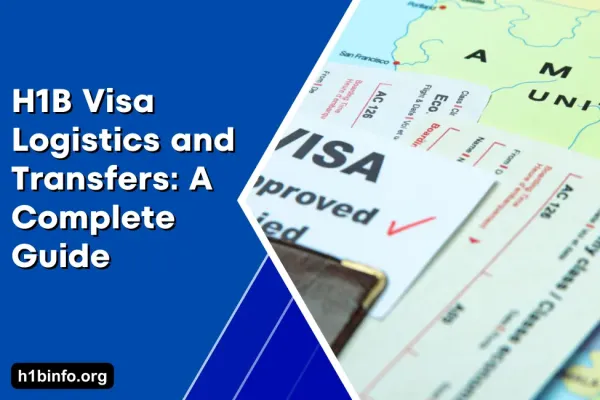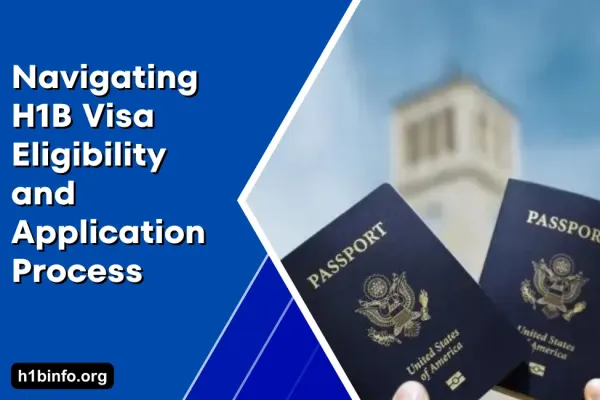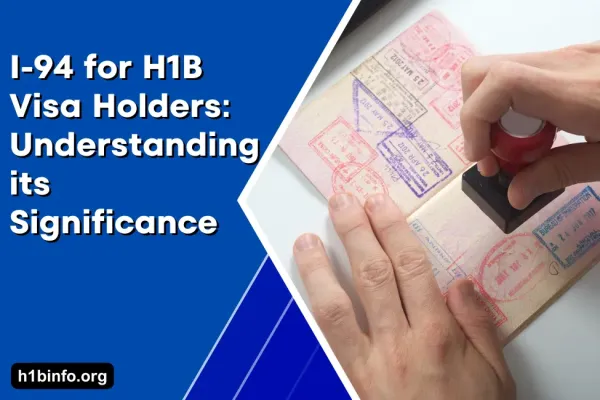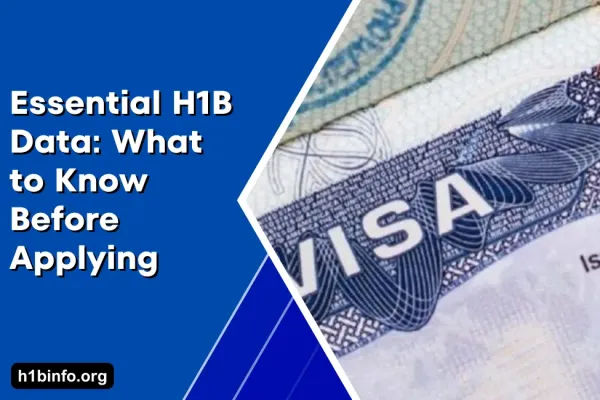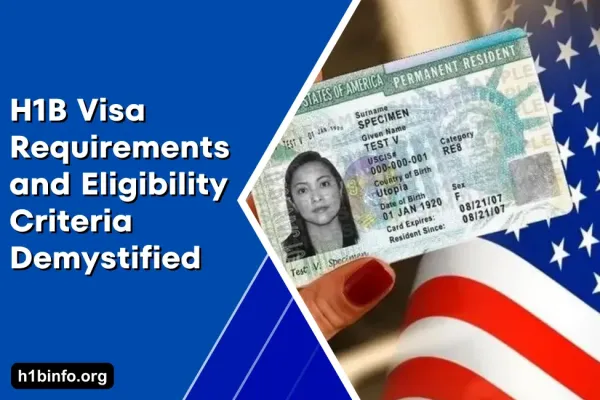The H1B visa is a special type of visa that allows people from other countries to come to the United States and work in jobs that require at least a bachelor's degree or equivalent work experience. The H1B visa is a great choice if you are from another country and have a job offer in the United States. In this guide, we will explain what you need to know about the H1B visa.
Required Job Profile for H1B Visa
The H1B visa is designed for people who want to work in special jobs in the United States. These jobs can be in various fields:
- Architecture
- Engineering
- Mathematics
- Physical Sciences
- Social Sciences
- Medicine
- Health
- Education
- Business
- Law
- Accounting
- Theology
- Arts
If there is an argument that the job requires a bachelor's degree, then you might be eligible for an H1B visa. You can work either full-time or part-time. Every year, there are 65,000 H1B visas available. Additionally, there are 20,000 more H1B visas for people with advanced degrees (like master's or juris doctor) from US schools.
H1B visas are valid for up to three years, and you can extend them for three more years, making it a total of six years. If you have a spouse and children, they can come to the US with you on H4 visas.
H1B visa holders can change employers, but they need to meet certain requirements. H1B beneficiaries can also pursue permanent immigration status because this visa allows for both temporary work and the possibility of staying in the US permanently.
Significance of H1B Visa
Having an H1B visa offers several advantages. Here are some of them:
-
You Can Legally Work in the United States: The H1B visa allows people from other countries to work in specialized jobs in the United States. This lets highly skilled individuals live and work in the US, which is beneficial for both them and the US economy.
-
You Can Also Work Towards Becoming a Permanent Resident: While the H1B is a temporary visa, it's different from other visas like B, H2B, H3, and J1, where you have to prove you're coming to the US for a temporary visit. With H1B, you just need to show that you plan to leave when your H1B status ends. You don't have to maintain a foreign residence. This means that while you're on an H1B visa, you can apply for benefits that could lead to getting a green card, without affecting your visa status.
-
Your Family can Come to the US with you: Your spouse and children who are under 21 and unmarried can get H4 status, which allows them to come to the United States with you. People with H4 status can go to school, but they can't work (with a few exceptions). Also, they need to be in the United States when the primary H1B visa holder is present; otherwise, their H4 status could be revoked.
-
H1B Visas Offer Flexibility: One significant advantage of the H1B visa is its flexibility. If you're on an H1B visa and change jobs, you can start working for a different employer as soon as you file your new application.
What Do You Need for an H1B Visa?
Getting an H1B visa is like following a set of rules. It's like a game, and we need to make sure we play it right. To make sure you can get this visa, you can talk to a special immigration lawyer. They are like your coach in this game. We can also help you gather proof to show you should get this visa. But remember, people who have an H1B visa might get surprise visits at work. It's like a surprise inspection to check if everything is as it should be.
-
Get a Job Offer
To start playing this visa game, you need to have a job offer from a company in the United States. It's like having an invitation to join a team. The company has to give you this offer in writing, like a letter or a contract. If there's no written offer, they can also tell you about it in a spoken agreement. But, they need to show proof that they need you.
-
A Special Work Relationship
One important rule in this game is that you and the company must have a special connection. It's like being on the same team. For this, the company has to be the boss. They get to decide when, where, and how you do your job. If they can't do this, your visa won't work.
The people who check these things will look at:
- Whether the company gives you tools or things you need for your job.
- If the company can hire, pay, or fire you.
- How they rate your work.
- If you get any job perks.
- If your name is on the company's tax papers.
- It's a bit tricky if you work away from the company, but if the company still has some control and you have a contract, it can still work.
-
No Fighting at Work
Here's another rule: if there's a fight or disagreement at your workplace, your visa won't work. The people who check these things will say no. But if your visa is already approved and there's a problem, everything will stop, and you won't be able to come to the United States.
Some Points to Consider During H1B Visa Processing
-
Is Your Job Special?
Not all jobs are the same. Some jobs need special knowledge or skills. It's like being a pro in a game. To know if your job is special enough, you can check:
- The Department of Labor's job guide.
- The Department of Labor's online job system.
- The Department of Labor's job dictionary.
- They don't care about your job title; they care about what you do at work. They'll look at your tasks, what's expected of you, and what you need for the job.
Other things they consider are:
- How much do you know and worked before?
- What kind of business does the company do?
- What's normal in that business?
- How much do you and others earn?
- How big the business is?
They might also check what people in your job did before and what jobs like yours are available now. Even if the job has the same title, it might be different, and that's why the rules can change. They pay attention to what your job is all about.
-
Do You Have a Bachelor’s or Higher Degree (or Equivalent)?
The job must require a bachelor’s degree (or higher) in a specific field of study related to the occupation. Not all foreign degrees titled “bachelor’s degree” are equivalent to a US institution’s bachelor’s degree.
USCIS may require a credentials evaluation of your foreign transcript and degree. This can help provide evidence that you meet the H1B bachelor’s requirement. The most popular credentials evaluator is the American Association of Collegiate Registrars and Admissions Officers Electronic Database for Global Education (AACRAO EDGE). It may be useful to highlight the relevant coursework in your transcript and tie it to the petitioner support letter.
-
Exceptions
- If you don't meet the usual education requirements for the job, you can still qualify for an H1B visa. You can achieve this by combining your education, training, and work experience. In this case, you must show that your previous experience is equivalent to a standard degree.
- Your prior work should involve both theoretical and practical use of specialized knowledge. Evidence supporting this may include:
- Recognition from leaders in your field.
- Materials published by you or about you.
- Proof of licensure.
- Evidence of significant contributions to your field.
- Results from CLEP or PONSI exams.
- Membership in a professional association.
- The necessary experience depends on the degree typically required for the job. If a doctoral degree is the norm, then you must have a doctorate. For instance, if a master's or advanced degree is usually expected, having a bachelor's degree along with five years of relevant work experience might be seen as equivalent. If a bachelor's degree is the requirement, three years of relevant work experience can be substituted for one year of education.
- You should have paid all outstanding fees. When submitting an H1B petition, the employer is responsible for paying all the necessary fees. If a specific fee isn't required, explain the reasoning in your cover letter.
- You must be licensed if federal, state, or local laws demand it. If the job mandates a license, the beneficiary must be licensed before H1B approval. If not, provide evidence showing a technical issue causing the delay. Remember, restricted licenses are valid for one year or until they expire, whichever is longer. Approval can't exceed the validity period of a temporary license. There are only two exceptions to this rule:
- If the state doesn't require a permanent license.
- If the state allows unlicensed individuals to practice under the supervision of a licensed supervisor.
- Healthcare professionals should note that state guidelines take precedence over OOH (Occupational Outlook Handbook) requirements. Those primarily involved in research or teaching, rather than patient care, do not need a license. Additionally, some other exceptions may apply to healthcare professionals.
- Having a license doesn't necessarily mean you're in a specialty occupation. For example, nursing requires a license but isn't considered a specialty occupation. Furthermore, not all specialty occupations require a license. If your position doesn't require one, you won't face discrimination for not having it.
Understanding the Limits of H1B Visas
Let's talk about the numbers when it comes to H1B visas. Each year, there are 65,000 H1B visas available, and there's an extra batch of 20,000 visas for those who have advanced degrees.
If your application isn't picked in the lottery or is submitted after the final receipt date, it won't be accepted. Also, if your application is missing important documents or fees, it'll get rejected too. This means you need to stay on top of your H1B visa application game. An immigration attorney can assist you in increasing your chances of success.
Because of the lottery system, many qualified applicants might never get reviewed. Some people are pushing for changes in this process. They argue that H1Bs should be reserved for the highest-paid or most skilled individuals. However, as of now, the lottery system remains in place.
Today, there's a special lottery system for those with advanced degrees, held before the regular one. If someone with an advanced degree doesn't get selected in the first lottery (which has 20,000 spots), they get another shot in the general lottery.
It's important to note that H1B1 visa holders (we'll discuss them later) don't count toward the H1B visa cap. The H1B1 has its limits: 1,400 for citizens of Chile and 5,400 for citizens of Singapore. Additionally, H4 dependents don't count toward this quota.
Lastly, there are some exceptions to keep in mind. Employees of certain organizations don't count toward the H1B visa limit, and these organizations are also exempt from the ACWIA fee:
- Colleges, universities, and nonprofits associated with higher education.
- Nonprofit or government research organizations.
-
Who Submits the Request?
A request for an H1B visa is typically submitted by a US company on behalf of a foreign individual who will be receiving the visa. In this process, the US company is known as the petitioner, and the foreign individual is referred to as the beneficiary.
-
What the Petitioner Needs to Do?
To file a successful petition, the petitioner needs to meet certain requirements:
- Extend a job offer to the beneficiary.
- Establish a valid employer-employee relationship with the beneficiary.
- Obtain an Internal Revenue Service Tax identification number.
-
Limitations on Petitions
Petitioners are allowed to submit only one petition for each beneficiary within a calendar year. If a petitioner submits multiple applications for the same beneficiary, the petition or visa application will be rejected or canceled. The only exception is if the petitioner receives notice of a delay in the initial filing. In such a case, the petitioner can submit a second petition along with an explanation and withdraw the first one.
However, multiple companies within the same corporate family can collectively submit a petition for the same beneficiary. In this scenario, each company must have its own Federal Employer Identification Number (FEIN) and a legitimate reason to hire the beneficiary.
-
Agent Representation
Alternatively, an agent can file an H1B petition on behalf of the petitioner. This agent acts as a representative of the petitioner and can file for multiple employers if the beneficiary will be working with more than one entity. It's important to note that when an agent files the petition, all the standard requirements must still be met.
-
Seeking Legal Assistance
If you require assistance with your H1B filing, you can consult with an immigration lawyer, such as myself or a member of my team. We are here to help you through the process.
H1B Visa Process Made Easy
The H1B visa process can seem complicated, but we'll break it down into simple steps for you:
-
Step #1: Applying for H1B Registration
In 2020, the Department of Homeland Security (DHS) introduced a new way to apply for H1B visas. This process is called "H1B CAP electronic registration." It applies to all employers who want to hire foreign workers with H1B visas. This rule also includes those who have advanced degrees.
-
Step #2: Getting Selected in the Lottery
For each worker they want to hire, employers must submit a separate registration application. If their application is chosen, they can then fill out Form I-129. Before this new process, they had to submit Form I-129 every year, even if their application wasn't picked.
-
Step #3: Paying the Registration Fee
To enter the registration process, you need to pay a $10 fee when you submit your electronic registration. Without this fee, your registration won't be considered valid.
-
Step #4: Sending Your H1B Petition
When you're ready to apply for your H1B visa, you'll need to send two copies of your H1B petition. One copy is the original, and the other is a copy for processing at a U.S. consulate. The mailing address you use depends on your employment details. An immigration lawyer can help you find the right address.
-
Step #5: Meeting the Deadline
As discussed in Section 4, it's crucial to submit your petition no later than April 1st. Your petition's receipt date is what matters, and all petitions received on the same day are treated equally. So, make sure you start preparing early!
-
Step #6: Required Documents
Here are some documents you might need when filing for your H1B visa:
- Form I-907: Only required if you want to pay extra for faster processing.
- Form I-129 with Supplement H: This form provides information about your U.S. employer, your job, and you, the worker.
Exhibit Packet: If you're changing your immigration status, you'll need evidence of your current lawful status, a copy of the passport's main page for you and any dependents, an approved labor condition application, a supporting statement from your U.S. employer, a cover letter from your attorney, and any other documents that support your case.
-
Step #7: Receiving Approval
When your petition is approved, you'll get an approval notice through Form I-797. If USCIS is happy with your petition, they'll process it for approval. But if they need more information, they might send a Request for Evidence (RFE), which means they need more proof to approve your application.
-
Step #8: Be Ready for USCIS Communication
USCIS may also send a Notice of Intent to Revoke or Deny (NOIR/NOID). You must respond within the given deadline and provide the evidence they ask for. If you don't, your petition may be rejected.
-
Step #9: Applying for a Visa
Once your petition is approved, you can schedule an appointment at a U.S. consulate. But remember, you can't apply for a visa more than 90 days before your job's start date. During the consulate interview, they'll mainly focus on your eligibility. So, bring a copy of your petition and evidence of your qualifications.
-
Step #10: Starting Work in the U.S.
Finally, if you're approved for an H1B visa, you can arrive in the United States up to 10 days before your job starts and stay up to 60 days after your H1B status ends (with some exceptions). Just make sure to have your passport, H1B visa, and Form I-797 approval handy. Also, check the expiration dates on your documents.
That's it! You've successfully navigated the H1B visa process in simple terms. Good luck with your journey to working in the United States!
H1B Visa Documentation
Getting all the necessary papers ready for your H1B visa application can be quite a task. Here's a simple list of what you might need. Remember, your specific case might require additional documents:
- A detailed description of your job
- A copy of your resume
- Your academic transcripts or certificates, along with an evaluation if needed
- Job listings for similar positions
- A written contract or a summary of your agreement
- Federal tax records
- Your business plan
- Proof that the degree is necessary for your job
- Evidence of any required licenses
- Copies of your training certificates, including a course outline
- Letters of support from previous employers, if applicable
- Basic information about your company
- Passport biographic pages for you and any dependents
- A job description from the Department of Labor (DOL)
- Statements from professional organizations, if applicable
H1B Visa Fees
The costs for the H1B visa are typically covered by the American employer or their representative. However, there might be other expenses linked to the H1B visa application process. These could involve fees for translations, photocopies, or transportation, which the person applying for the visa might need to pay. Please keep in mind that the fees mentioned in this guide can change over time.
- ACWIA Fee: $1,500 for employers with 26 or more employees, and $750 for employers with 25 or fewer employees.
- Fraud Prevention and Detection Fee: $500
- For petitioners with 50 or more employees and with 50% or more of their employees holding H-1B, L-1A, or L-1B status (if applicable): $4,000
- Form I-129 Fee: $460
- Premium Processing Fee (Form I-907): $1,440 (this fee can be paid by the person applying for the visa)
H1B Visa Processing Time
The time it takes to process an H1B visa application and receive approval can vary widely depending on several factors, including:
- Whether you choose to use premium processing,
- The type of H1B visa you are applying for (cap-exempt, advanced degree, regular),
- The USCIS Service Center you use for your application,
- The U.S. consulate where you get your visa stamped (if you are outside the United States).
As a result, the processing time can range from less than two months to over nine months. Additionally, it's important to note that regardless of the approval date, individuals granted the visa will not be eligible to start working until October 1st following the lottery.
Amending an H1B Visa
When someone starts working in the United States with an H1B visa, there are a few important things to keep in mind. If the person changes employers or alters 50% of their job duties, they must file a new or amended petition.
If there's a change in the worksite, they also need to submit a new labor condition application. If the job unexpectedly ends, the individual can stay in the country for up to 60 days or until the visa expires, whichever is shorter.
During this time, they can try to find a new employer but can't work. It's crucial to take note of any changes in the person's job or the U.S. company. In such cases, consulting an immigration lawyer can help you understand what steps are necessary to comply with the H1B visa program.
Furthermore, an H1B visa is valid for a maximum of three years. To stay beyond this period for up to an additional three years, an extension must be requested. This request should be made while the person is still in valid H1B status. The extension isn't guaranteed and doesn't have to be for the full three years.
To improve the application's chances, provide documentation that demonstrates the ongoing need for the H1B beneficiary. This documentation can include copies of pay records, work schedules, evaluations, and work completed by the beneficiary.
Limits in Time
As mentioned earlier, H1B visas are valid for up to six years. However, it's important to understand that time spent in L status counts toward this six-year limit. But, this limit only applies to time physically spent in the United States. If someone can show that they spent time outside the United States, that time doesn't count toward the six-year H1B maximum. This time can be "recaptured" and used to extend their H1B status.
For instance, if an individual returned to their home country for one week each year, totaling six weeks, this time can be recaptured. In this case, the person would be eligible to spend an additional six weeks in the United States under H1B status. Please keep in mind that only full days spent outside the United States are eligible for recapture.
If any part of the day was spent in the United States, such as a travel day, it cannot be recaptured.
H1B Visa to Green Card
While you're on an H1B visa, you have the option to apply for permanent resident status in the United States. Moreover, if you're waiting for a specific date to get an immigrant visa, you might be allowed to stay in the U.S. on an H1B for more than six years. You could also be eligible to keep your H1B status for a longer period if you have an approved EB-1, EB-2, and/or EB-3 petition.
If you have any questions about the process of transitioning from an H1B visa to becoming a permanent resident in the United States, you can seek guidance from an immigration attorney, such as myself, or a member of my team.
H1B Visa Exceptions
People from Chile and Singapore have the chance to get H1B1 status. H1B1 visas are valid for as long as 18 months and can be renewed without any limits. You can apply for these visas either through USCIS or at a U.S. consulate in another country. Those under H1B1 status are not part of the 65,000 visa cap, and they don't have to follow the same six-year maximum stay rule as H1B visa holders.
Some jobs that are not categorized as specialty occupations and are not eligible for an H1B visa might be accepted under the H1B1 visa. If you think you might qualify for an H1B1 visa, an immigration attorney, like myself or someone else on my team, can provide you with further assistance.
Applicants for an H1B1 visa have the option to apply directly at the consulate or through USCIS for a change of status. When they go for their visa appointment at the consulate, they can provide all the necessary documents directly to a consular officer. There's no need for them to have approval before their consular appointment.
Changing from F1 Visa to H1B Visa
Many of our clients switch from an F-1 visa, which is for students, to an H1B visa. If you're on an F-1 visa, you can have one year of practical training after you finish your education. If you're studying in STEM fields (Science, Technology, Engineering, and Mathematics), you might get a chance to extend your practical training for another 24 months. During this practical training, you'll be applying what you learned in your specialized field. The work you do must relate to the degree you earned.
Employers have the option to apply for H1B visas for students who are in practical training and they want to hire for a longer period, as long as the students meet all the requirements mentioned here.
Some international students finish their practical training but can't start their H1B employment right away. In such cases, they might be able to stay in the United States without going back to their home country during this gap period. However, they won't be allowed to work in the United States during this time.
This "cap-gap relief" saves you from the trouble and expense of traveling back and forth between the US and your home country. If you have any questions about this process, an immigration lawyer, like me or someone from my team, would be happy to help you out.
